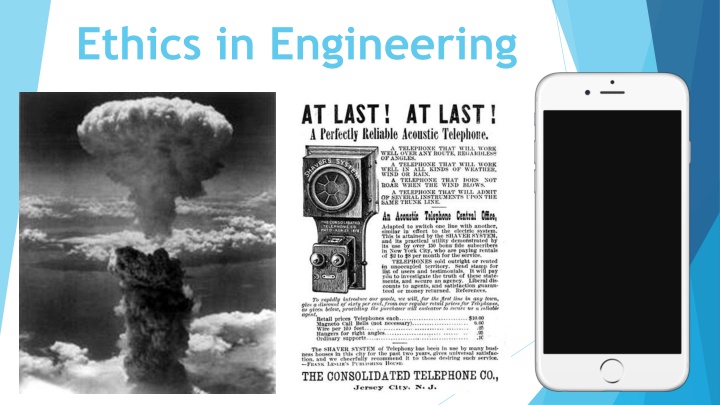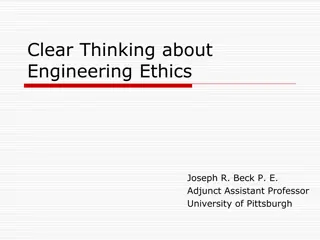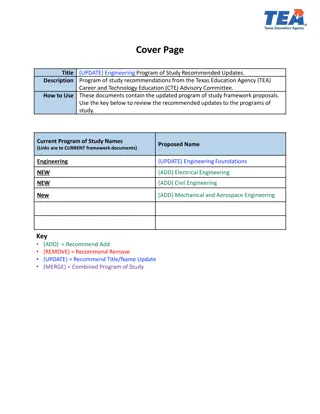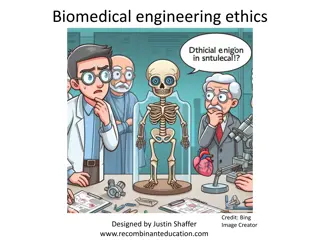Ethics in Engineering - Day 1 Activities
Engage in interactive activities focusing on exploring innovations, evaluating designs, defining ethics, and more. Collaborate to identify top inventions and analyze their impact. Discover the significance of engineering in making a difference.
Download Presentation

Please find below an Image/Link to download the presentation.
The content on the website is provided AS IS for your information and personal use only. It may not be sold, licensed, or shared on other websites without obtaining consent from the author.If you encounter any issues during the download, it is possible that the publisher has removed the file from their server.
You are allowed to download the files provided on this website for personal or commercial use, subject to the condition that they are used lawfully. All files are the property of their respective owners.
The content on the website is provided AS IS for your information and personal use only. It may not be sold, licensed, or shared on other websites without obtaining consent from the author.
E N D
Presentation Transcript
Day 1 Goals Exploring new innovations Evaluating designs Identifying intended demographics Defining ethics Considering the impacts of testing
Group and Label Activity Time magazine publishes a list of the Best Inventions of the Year Printouts of these inventions are on your desks Working in small teams, sort the inventions into groups. Then label each group with a sticky note. Possible criteria: location, funding source, creator, purpose, materials, audience or other characteristics of your own choosing Examples: digital/non-digital ASIMO (Advanced Step in Innovative Mobility) is a humanoid robot developed by Honda to work as a a mobile assistant. needs/wants
Think/Pair/Share Imagine you are editors at Time Magazine. You must identify one invention as the best invention of the year and one as the runner up. The winning inventions must be from the 16 inventions in your pile. With your partner, discuss: Which is the best invention and why? Which is the runner up and why?
And the award goes to. You have two stickers. Place them on the 2 inventions that you think are the most deserving of recognition. Do this activity individually.
Analysis: About Your Choices Which 2 inventions received the most stickers? If you voted for them, why did you feel they were most deserving? Does anyone feel a different invention would have been more deserving? Who will those inventions help? Who can afford to use them? Which 2 inventions got the fewest stickers? Why didn t more people vote for them?
Engineers Make a World of Difference For whom does engineering make the world a better place? In what ways does engineering make a difference? Jonas Salk s polio vaccine saved hundreds of thousands of people around the world from paralysis.
Analyze Two Designs In your small groups, identify the top 2 designs Then answer the worksheet questions about those inventions On the following slides, example answers are provided for analyzing the disposable pill packets
Example Answers for the disposable pill packets 1. Who does this design benefit? In what ways? This design benefits people who are chronically ill or their caregivers. It helps them keep track of medications. It is for people who can afford multiple medications and/or who have the insurance coverage for multiple medications. 2. Who or what might be harmed by this design? In what ways? A new study estimates that 8 million metric tons of trash the midpoint of the researchers estimate enters the ocean from land each year. That's equivalent to about 1.5 million cars. The environment might be harmed if the materials are not easily degradable.
Example Answers (continued) for the disposable pill packets 3. Who might be discouraged or excluded from using this design? This design is not for people who cannot read or who are cognitively impaired. It is probably not for people in countries who do not have access to medicines. 4. Who funded the development of this design, and why do you think they funded it? A pharmacy funded this design, perhaps so people would order drugs from their pharmacy. 5. After looking more critically at this design, is there anything else you noticed? How do people with vision problems read this design?
The Engineering Code of Ethics Review the engineering code of ethics at: http://www.nspe.org/resources/ethics/code-ethics Create a class definition of ethics. To do this, decide on the five principles you believe are the most important. Keep these five principles in mind as we progress through the activity.
Who is the product tested on? Historically, women have been under-represented in product and safety testing, which has led to dangerous confusion when it comes to automotive safety and medication dosage.
Who is the product tested on? Do the benefits of the research outweigh the rights of the subjects? Josef Mengele conducted painful and deadly medical experiments on WW2 concentration camp prisoners. Jonas Salk deliberately infected mental hospital patients with influenza.
Who benefits from this product and who does not? Reflect on how these four considerations add up to doing good. How does the product help or hurt people and the environment? Doing good for people How is the product made? Based on your class definition of ethics, is there anything you would add or change? How is this product tested?
Critical and Ethical Thinking in Engineering Read article about the Od n Device: Car Mechanic Dreams up a Tool to Ease Births As you read the article, fill in the graphic organizer on the worksheet with at least 5 questions about the article. Question topics: manufacturing, testing, availability, impact, another topic of your choice
Example Questions To help you formulate your questions, here are a few example questions about a different device the Hemopurifier, a blood filter that fights Ebola. Testing: Why was the Hemopurifier only tested on a person in Germany and not on people in Africa? Manufacturing: How much does the hemopurifier cost to make. How much is it sold for? Availability: What kinds of medical facilities are needed for this design to work? How many hospitals around the world have dialysis machines?























